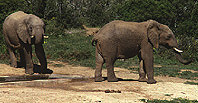
Elephants
Elephants live in a complex matriarchal society normally
composed of 8 to 15 members and led by a dominant cow. Three or
four generations of cows and calves spend their entire lives
together with the exception of males,
who leave the group at puberty. Groups of related families
stay in fairly close range of each other and communicate often;
these are called kin groups. In times of danger, kin groups will
mass and form clans of 200 or more. The top mental ability is at
age 30 to 45. Death comes at 65 to 70 years of age.
The adult male is much larger than the adult female. Head and
body length including trunk: 19-24 feet. Brownish gray skin has
and folds may be up to one inch thick in places. The African
Elephant has a marked dip between its fore and hindquarters
giving a concave curvature to its back. Ears are large and
fan-like. The end of the trunk is adapted to wrap around a object
for holding things at the tip. Large tusks are present in both
sexes.
The elephant home range is 500 miles; migratory patterns are
taught from one generation to the next. Now they are mostly
restricted to parks and preserves. Habitat formerly was south of
the Sahara; agricultural expansion has severely reduced it.
Highly adaptable, elephants can survive in forest, bush or
Savannah.
Elephants have and inefficient digestive system and digest
only about 40 per cent of what they eat. They eat enormously.
Estimates in the wild range from 100- 1000 pounds of vegetation
per day (a 16 hour period). Zoo elephants are estimated to eat
approximately 50 pounds of food per ton of elephant per day.
Working elephants need 300 to 600 pounds of food per day. The
wild elephant is a destructive eater, uprooting and scattering as
much as is eaten, often breaking down whole trees.
return to South Hamilton Biology
home page

